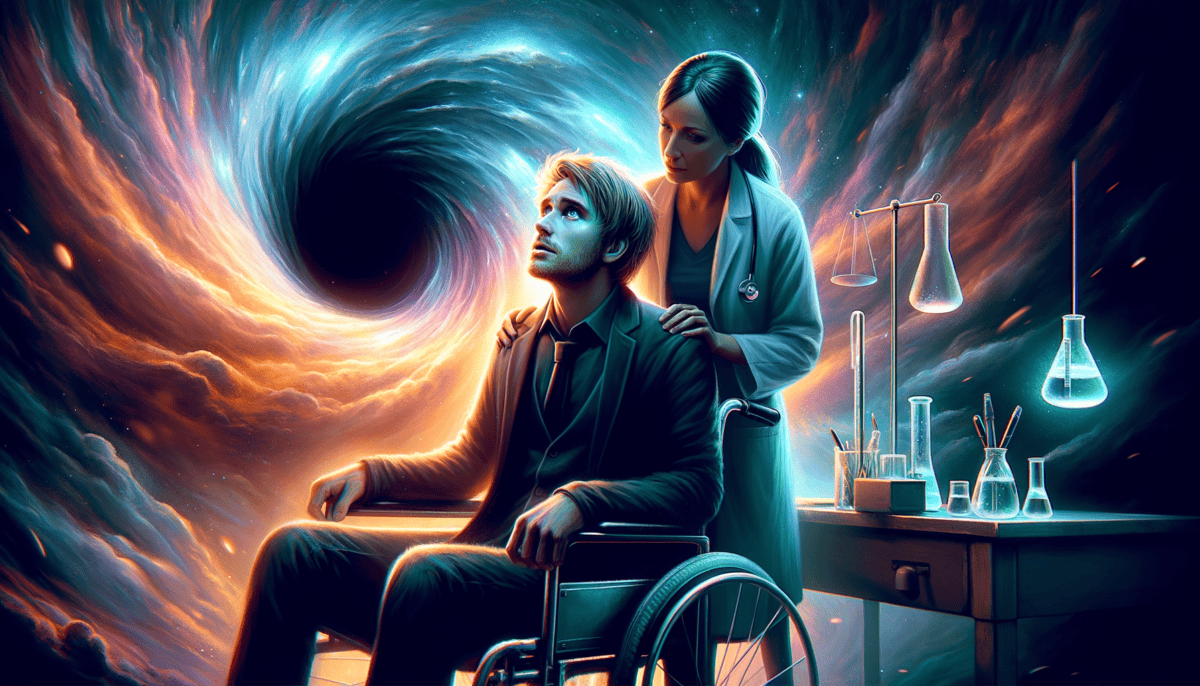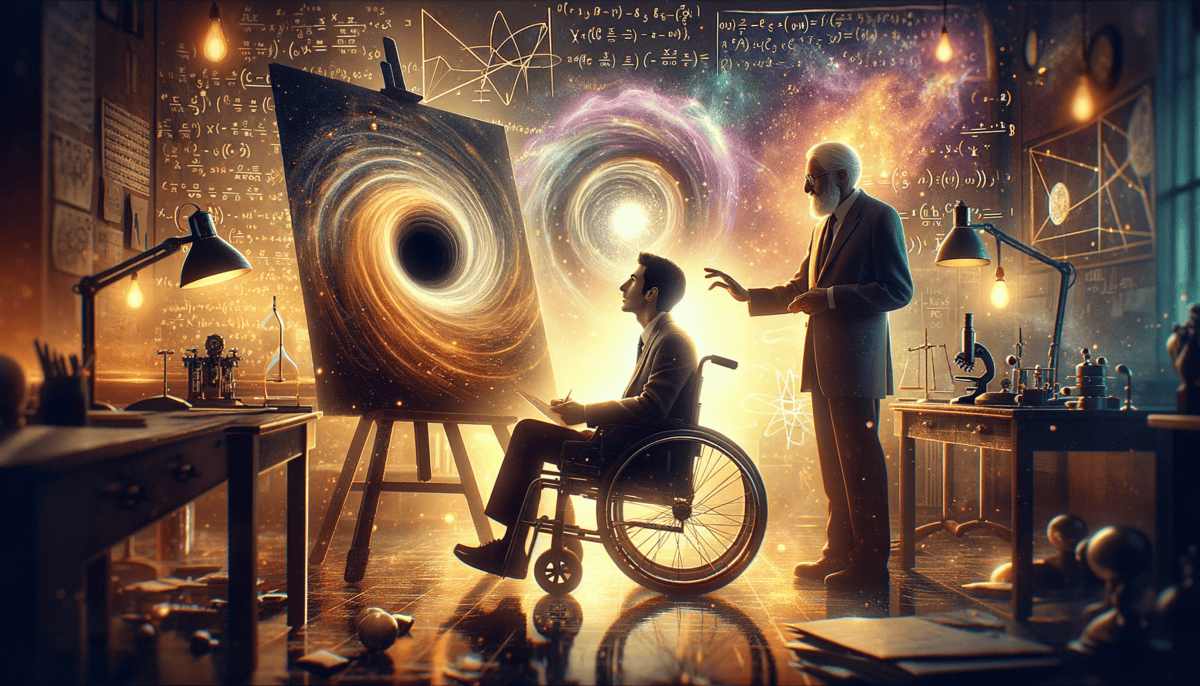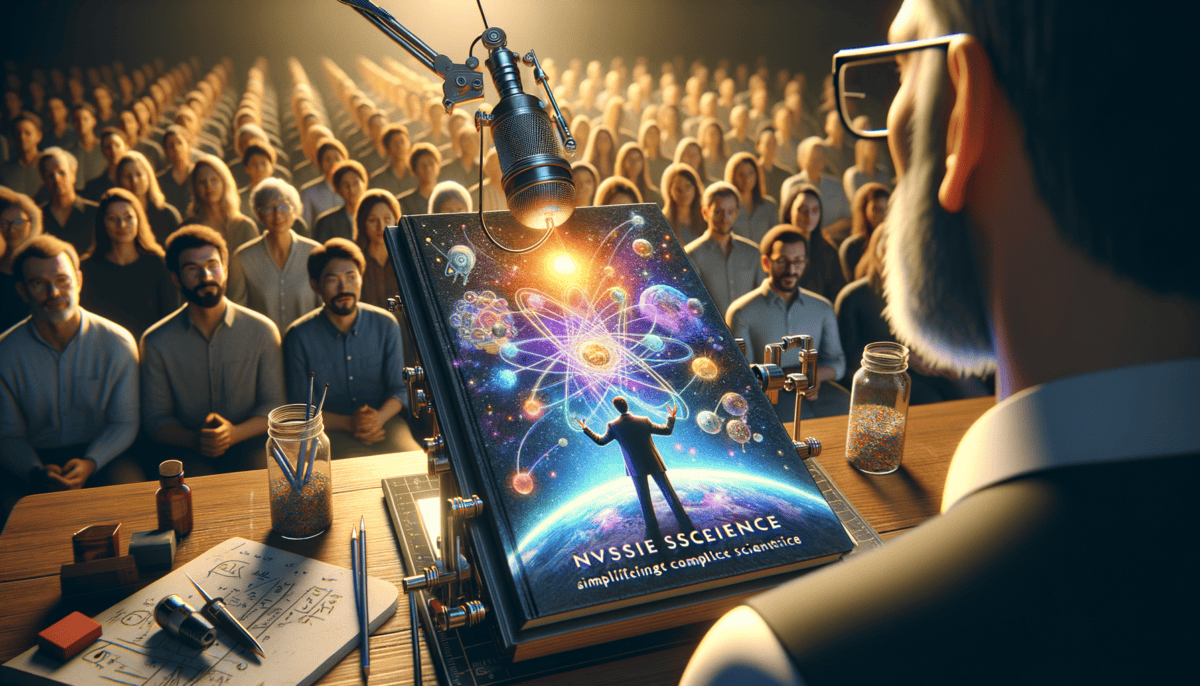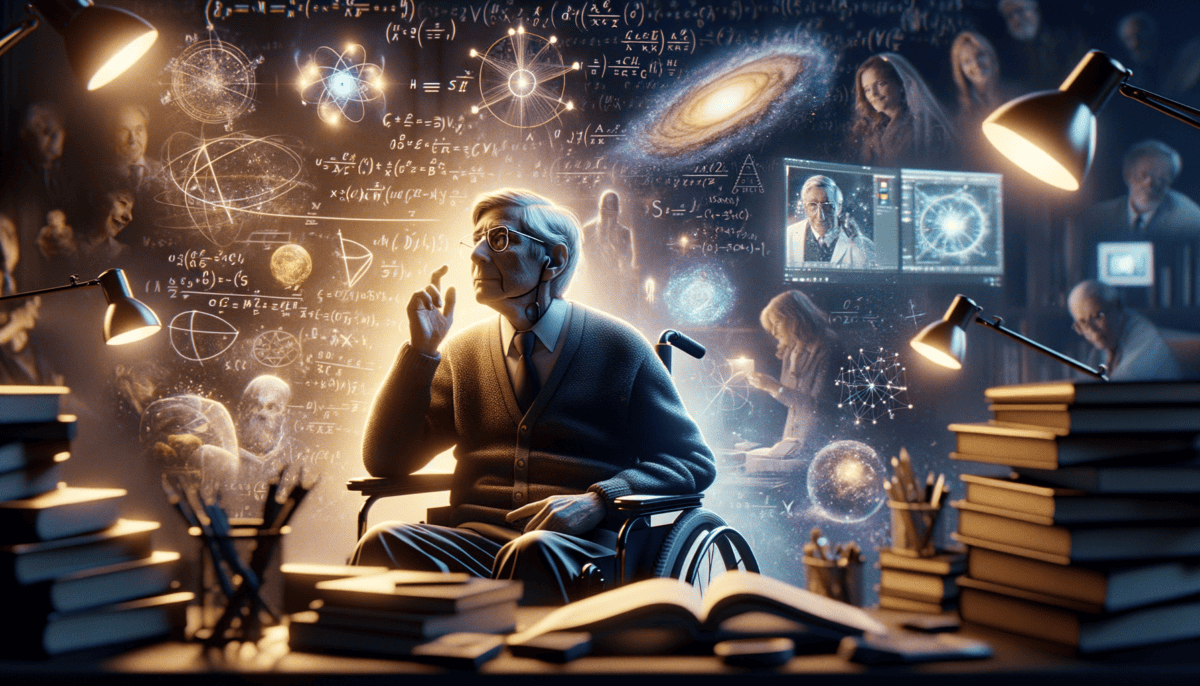A Curious Mind in Oxford
Little Stephen peered through his bedroom window at the starlit sky. It was 1950 in Oxford, England, and eight-year-old Stephen Hawking couldn't stop wondering about the twinkling lights above.
"Mummy, why do the stars shine?" he asked one evening.
His mother, Isobel, smiled. "That's the kind of question scientists try to answer, dear."
Stephen's eyes sparkled. "Then I want to be a scientist!"
At school, Stephen wasn't the top student in his class. His handwriting was messy, and sometimes he struggled to pay attention. But when it came to numbers and puzzles, his mind worked like magic! ✨
"Look at this, Father!" Stephen exclaimed one day, showing his dad a complex math problem he'd solved.
Frank Hawking, a doctor who studied tropical diseases, nodded proudly. "Keep asking questions, son. That's how we learn about our world."
Building Dreams with Numbers
Stephen's childhood home was different from others. Instead of watching TV (they didn't have one!), the family would:
• Read books about science and nature
• Play board games that made them think
• Have long discussions about interesting ideas
• Go on nature walks to explore
• Do mathematical puzzles together
One day at school, Stephen's teacher Mr. Thompson noticed something special. While other kids struggled with basic math, Stephen was already solving problems meant for older students.
"Stephen," Mr. Thompson said, "you have a gift for numbers. Never stop using it."
Finding His Path
As Stephen grew older, his curiosity about the universe only got bigger. He started building model airplanes and boats, always wanting to understand how things moved through space.
"Why does everything fall down?" he asked during dinner one evening.
"That's gravity," his sister Mary explained.
"But why does gravity work?" Stephen persisted.
Sometimes, other kids thought Stephen was a bit odd. He talked about stars and planets when they wanted to talk about games and sports. But Stephen didn't mind being different. He knew his curious mind would take him places.
His childhood friend John remembered: "Stephen always looked at things differently. He didn't just accept what people told him – he wanted to figure things out for himself."
Dreams Taking Flight
By the time Stephen was thirteen, he knew exactly what he wanted to do with his life. While other kids dreamed of being firefighters or teachers, Stephen dreamed of understanding the biggest mystery of all – how the universe worked.
One night, lying on the grass in his backyard, Stephen made a promise to himself. He would solve the puzzles of the stars above. He didn't know it then, but this curious little boy from Oxford would grow up to change how we think about space, time, and everything in between.
The stars twinkled down at him, as if they knew their secrets would one day be discovered by this determined young dreamer.
Finding Strength in Darkness
The year was 1963, and Stephen’s world turned upside down. At just 21 years old, doctors gave him news that would change everything.
“You have ALS,” the doctor said quietly. “Most people with this condition live for about two years.”
Stephen sat in the hospital room, his mind spinning. His hands had been getting clumsy, and he’d been falling for no reason. Now he knew why.
A Light Named Jane
Just when things seemed darkest, Stephen met someone special. Her name was Jane Wilde, and she had the prettiest smile he’d ever seen. ✨
“I don’t care about your illness,” Jane told him. “I care about you.”
Their love story began at a New Year’s party. Even though Stephen was using a cane to walk, Jane saw past his struggles. She saw his brilliant mind and kind heart.
Fighting Back
Instead of giving up, Stephen made a big decision. He would:
• Keep studying physics
• Marry Jane
• Try to understand black holes
• Live each day to the fullest
• Show the world what he could do
A New Way of Thinking
As walking became harder, Stephen started thinking about space in new ways. He couldn’t run around like before, but his mind could travel to the farthest corners of the universe.
“Maybe,” he thought one day, “not being able to move much is helping me think better about how the universe moves.”
Jane helped him write when his hands got shaky. She believed in him, even when others doubted.
Love Conquers All
“Will you marry me?” Stephen asked Jane one evening.
“Yes!” she answered without hesitation.
They got married in 1965. The church was full of friends and family who supported their love. Stephen used two canes to walk down the aisle, but his smile was brighter than ever.
A New Adventure Begins
Even though Stephen’s body was getting weaker, his dreams were getting bigger. He started studying the biggest mysteries in space – things called black holes.
“If I can’t dance with my feet,” he joked with Jane, “I’ll dance with the stars in my mind.”
Every morning, Jane would help Stephen get ready for work at Cambridge University. Together, they showed the world that love and determination could overcome any challenge.
The doctors had said Stephen would only live two years. But Stephen had other plans. He was going to prove that a brilliant mind could shine even when the body grew weak.
As the sun set each evening, Stephen would look out his window at the same stars he’d loved as a child. Now, more than ever, he was determined to unlock their secrets. His journey was just beginning.
Dancing with Black Holes
Stephen wheeled his chair to the chalkboard, his mind buzzing with new ideas. Even though his body moved slowly, his thoughts raced like shooting stars.
A Special Friend
One day, a mathematician named Roger Penrose came to visit Stephen at Cambridge. They both loved thinking about space.
“What happens when stars die?” Roger asked.
Stephen’s eyes lit up. “Let’s find out together!”
The Big Discovery
Stephen and Roger worked hard every day. They wrote lots of math on big boards. Sometimes they made mistakes, but they never gave up.
Then one morning, Stephen had an amazing idea. He figured out that black holes weren’t just big dark spots in space. They were sending out tiny bits of light!
New Ways to Talk
As time went by, Stephen’s voice got softer. But he didn’t let that stop him. He got a special computer that could talk for him.
“Now I can say anything I want,” he typed with a smile. “Even jokes about black holes!”
The computer had a robot voice, but everyone loved hearing Stephen’s smart ideas through it.
Breaking the Rules
Many people thought they knew everything about space. But Stephen showed them new things to think about:
• Black holes aren’t completely black
• The universe had a beginning
• Time can bend like a rubber band
• Space is full of surprises
• Anyone can be a scientist
Never Giving Up
Some days were hard. Stephen’s hands shook when he tried to write. But Jane was always there to help.
“You’re changing how we see the universe,” she told him.
Stars in His Eyes
At night, Stephen would look up at the stars through his window. His body might have been in a wheelchair, but his mind soared through space.
“Every star has a story,” he typed to Jane. “And I want to read them all.”
The doctors had said Stephen wouldn’t live long. But here he was, making amazing discoveries about space. He showed everyone that big dreams don’t need a perfect body – just a curious mind and a brave heart.
Teaching Others
Students loved learning from Stephen. He made hard ideas seem fun and easy.
“Did you know,” he would type with a twinkle in his eye, “that time moves slower near a black hole?”
The students would lean forward, excited to learn more from their teacher who danced with stars in his mind. ⭐
Finding His Voice
The year was 1985, and Stephen faced a big problem. His voice was getting harder to understand. But just like always, he wasn’t going to let that stop him! ️
A New Way to Talk
At first, Stephen used a hand clicker to pick letters. But soon, he could only move his cheek muscle. His friend Walt made him a special switch that worked with just a tiny movement.
“I may not speak like before,” Stephen typed, “but I still have lots to say!”
Writing for Everyone
One day, Stephen had a big idea. “I want to write a book that everyone can read,” he told Jane. “A book about space and time that’s fun!”
That book became “A Brief History of Time.” It was like magic – Stephen could explain big ideas about space in ways that made sense to everyone!
Making Science Fun
Stephen loved to make people laugh while teaching them about space. His robot voice would tell jokes during talks:
“Why did the gravity wave feel lonely? Because it had no mass-ter!”
People smiled when they heard his jokes. They learned that science could be fun!
Traveling the World
Even in his wheelchair, Stephen went everywhere. He floated in zero gravity in a special airplane. He met queens and presidents. He even appeared on TV shows!
Teaching with Technology
Stephen’s special computer got better over time. It could:
• Speak faster
• Write equations
• Control his wheelchair
• Send emails
• Browse the internet
Inspiring Others
“Never give up,” Stephen would type to students who felt scared or different. “The universe is full of wonder, and so are you!”
People everywhere learned from Stephen that you don’t need to speak loudly to have a powerful voice. Your ideas can change the world! ⭐
Sharing His Story
News shows wanted to talk to Stephen. Movies were made about his life. He showed everyone that being different didn’t mean being less amazing.
“Look up at the stars,” he typed once. “They’re bright enough for everyone to see!”
A Star Among Stars
The letters and emails kept coming! People from all over the world wanted to hear Stephen talk about space. His wheelchair zoomed from city to city, sharing big ideas about the universe.
Meeting Famous Friends
“Welcome, Professor Hawking!” said Queen Elizabeth with a smile. Stephen’s computer voice replied, “It’s an honor to meet you, Your Majesty.”
Teaching Big Ideas
At big talks, people filled huge rooms to listen to Stephen. He made hard space stuff easy to understand:
“Black holes are like giant vacuum cleaners in space,” his computer voice would say. “They suck up everything nearby – even light!”
Kids especially loved when he explained things with silly examples.
Movie Star Scientist
Hollywood came calling! They wanted to make a movie about Stephen’s life. It was called “The Theory of Everything.”
Actor Eddie Redmayne played Stephen. He learned exactly how Stephen moved and smiled. The movie won lots of awards!
Helper and Friend
Stephen didn’t just think about space. He helped other people who couldn’t walk or talk:
• Shared his special computer technology
• Spoke up for disabled rights
• Showed that wheelchairs shouldn’t stop dreams
• Gave hope to sick people
Still Making Discoveries
Even as he got older, Stephen kept thinking up new ideas about space. He wondered about:
“Are there other universes out there?”
“Can we travel through time?”
“What happened before the Big Bang?”
Sharing With Everyone
Stephen wrote more books. But this time, he wrote special ones for kids! He wanted young people to love space as much as he did.
“Remember,” his computer would say at school visits, “every star you see at night has a story to tell.”
Making Science Cool
TV shows wanted Stephen to visit. He appeared on:
• The Simpsons (as a cartoon!)
• The Big Bang Theory
• Comic shows
• News programs
He showed everyone that scientists could be fun and cool!
Always Looking Up
“The universe is beautiful,” Stephen typed one evening, watching stars twinkle. “And anyone can study it, no matter who they are.”
Beyond the Stars Forever
The stars twinkled extra bright on March 14, 2018. It was as if they knew they were welcoming home one of their greatest friends – Stephen Hawking.
Last Space Dreams
Even in his final years, Stephen kept exploring the cosmos with his amazing mind. His eyes would light up whenever he talked about black holes or space adventures.
Stephen’s Space Treasures
Stephen left us wonderful gifts that help us understand space better:
• Ideas about black holes that changed science forever
• Books that made space fun for everyone
• Hope that nothing can stop big dreams
• Proof that our minds are stronger than any challenge
The World Says Goodbye
“Professor Hawking wasn’t just a brilliant scientist,” said one young student at Cambridge. “He showed us that anything is possible!”
People everywhere shared stories about how Stephen changed their lives:
A Special Resting Place
Stephen’s ashes were placed in a very special spot – right between Isaac Newton and Charles Darwin in Westminster Abbey. Three great minds who changed how we see our world!
Still Teaching Us
Even though Stephen isn’t here anymore, his ideas keep teaching us:
“Look up at the stars, not down at your feet,” his famous words remind us. “Be curious, and no matter how hard life seems, there is always something you can do and succeed at.” ⭐
New Space Explorers
All around the world, kids who learned about Stephen are becoming scientists:
Forever in the Stars
Scientists named a special star after Stephen. It’s called “Hawking Star,” and it shines extra bright in the night sky.
When people look up and see it twinkling, they remember:
“Nothing is impossible if you dream big enough!”
The Story Continues
Stephen’s story didn’t end when he left Earth. It lives on in:
• Every child who looks up at the stars with wonder
• Every person who faces challenges with courage
• Every scientist who asks big questions
• Every dreamer who believes in impossible things
Somewhere out there, among the twinkling stars and mysterious black holes, Stephen’s spirit continues to explore the endless wonders of space, inviting us all to join in the greatest adventure of all – discovering the secrets of our amazing universe! ✨






